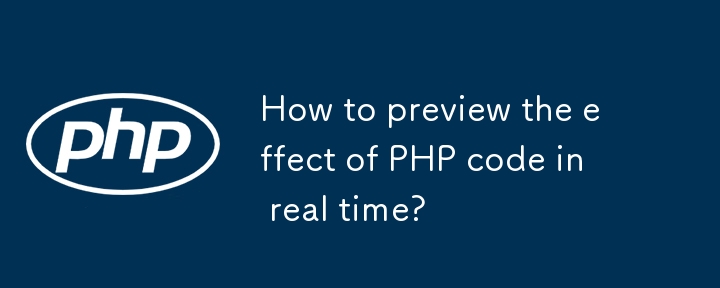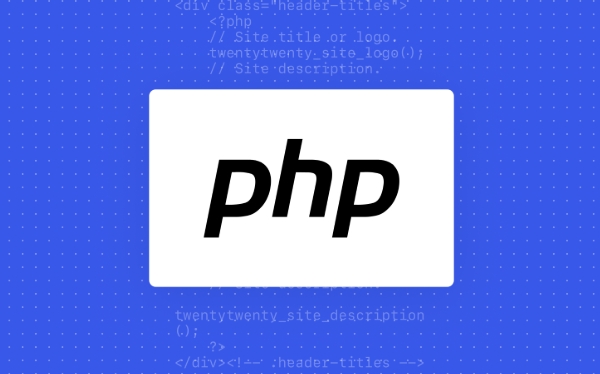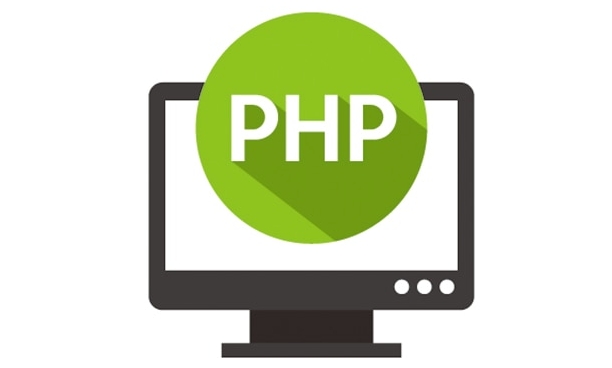To achieve real-time preview of PHP code effects, you need to build a local development environment and use it with the tools. 1. Use XAMPP, WAMP or MAMP to build a local server, place the PHP file in a specified directory and access it through localhost, and refresh the page after modification to view the results; 2. Use VS Code's Live Server plug-in or PHPStorm to save and automatically refresh the browser; 3. Use var_dump() or print_r() to debug output variable information in combination with browser developer tools to assist in troubleshooting problems. Although these methods are not completely real-time, they can quickly feedback the results and improve development efficiency.

If you want to see the effect in real time while writing PHP code, it can be a bit challenging. Because PHP is a server-side language, it is not as previewed directly in the browser like HTML or JavaScript. However, through some tools and settings, you can still achieve a close-to-"real-time preview" experience.

Build a local development environment
To run PHP code, you must first have a local server environment. The easiest way is to use integration packages like XAMPP, WAMP, or MAMP, which include Apache, MySQL, and PHP, and can quickly start the local server after installation.

- After the installation is complete, place your PHP file in
htdocs(XAMPP) or similar directory - Start the Apache service
- Visit
http://localhost/你的文件名.phpin your browser to see the execution results
In this way, after each modification and saving the code, you can refresh the page and see the latest effect. Although it is not completely "real-time", the response speed is very fast and can basically meet most needs.
Real-time refresh plug-in using a lightweight editor
Some editors can automatically refresh the browser after saving through plug-ins. for example:

- VS Code : With the "Live Server" plug-in, although it is mainly aimed at static files, it can also be used in PHP pages in combination with local servers.
- PHPStorm : More complete PHP support is built-in. After configuring the server, you can achieve the effect of saving and refreshing.
The core logic of this type of tool is to listen for file changes and then trigger the browser to reload, so that you don't have to press F5 manually.
Debugging output with browser developer tools
If you want to see variable values ??or intermediate results, rather than the entire page rendering effect, you can use var_dump() or print_r() to output information, and then view it in combination with browser developer tools.
Tips: In order to make the output clearer, you can add a sentence
echo '<pre class="brush:php;toolbar:false">';</pre>before it, so that the format will be easier to read.
Of course, this method is more suitable for debugging and cannot replace real previewing, but it is very practical when troubleshooting problems.
Basically these are the methods. Although PHP itself does not support direct preview like the front-end, as long as the local environment is well built and the right tools can also provide near-real-time feedback. The key is to choose a convenient editor and match the server. The rest is to save the code a few more times when writing it.
The above is the detailed content of How to preview the effect of PHP code in real time?. For more information, please follow other related articles on the PHP Chinese website!

Hot AI Tools

Undress AI Tool
Undress images for free

Undresser.AI Undress
AI-powered app for creating realistic nude photos

AI Clothes Remover
Online AI tool for removing clothes from photos.

Clothoff.io
AI clothes remover

Video Face Swap
Swap faces in any video effortlessly with our completely free AI face swap tool!

Hot Article

Hot Tools

Notepad++7.3.1
Easy-to-use and free code editor

SublimeText3 Chinese version
Chinese version, very easy to use

Zend Studio 13.0.1
Powerful PHP integrated development environment

Dreamweaver CS6
Visual web development tools

SublimeText3 Mac version
God-level code editing software (SublimeText3)

Hot Topics
 PHP Variable Scope Explained
Jul 17, 2025 am 04:16 AM
PHP Variable Scope Explained
Jul 17, 2025 am 04:16 AM
Common problems and solutions for PHP variable scope include: 1. The global variable cannot be accessed within the function, and it needs to be passed in using the global keyword or parameter; 2. The static variable is declared with static, and it is only initialized once and the value is maintained between multiple calls; 3. Hyperglobal variables such as $_GET and $_POST can be used directly in any scope, but you need to pay attention to safe filtering; 4. Anonymous functions need to introduce parent scope variables through the use keyword, and when modifying external variables, you need to pass a reference. Mastering these rules can help avoid errors and improve code stability.
 How to handle File Uploads securely in PHP?
Jul 08, 2025 am 02:37 AM
How to handle File Uploads securely in PHP?
Jul 08, 2025 am 02:37 AM
To safely handle PHP file uploads, you need to verify the source and type, control the file name and path, set server restrictions, and process media files twice. 1. Verify the upload source to prevent CSRF through token and detect the real MIME type through finfo_file using whitelist control; 2. Rename the file to a random string and determine the extension to store it in a non-Web directory according to the detection type; 3. PHP configuration limits the upload size and temporary directory Nginx/Apache prohibits access to the upload directory; 4. The GD library resaves the pictures to clear potential malicious data.
 Commenting Out Code in PHP
Jul 18, 2025 am 04:57 AM
Commenting Out Code in PHP
Jul 18, 2025 am 04:57 AM
There are three common methods for PHP comment code: 1. Use // or # to block one line of code, and it is recommended to use //; 2. Use /.../ to wrap code blocks with multiple lines, which cannot be nested but can be crossed; 3. Combination skills comments such as using /if(){}/ to control logic blocks, or to improve efficiency with editor shortcut keys, you should pay attention to closing symbols and avoid nesting when using them.
 How Do Generators Work in PHP?
Jul 11, 2025 am 03:12 AM
How Do Generators Work in PHP?
Jul 11, 2025 am 03:12 AM
AgeneratorinPHPisamemory-efficientwaytoiterateoverlargedatasetsbyyieldingvaluesoneatatimeinsteadofreturningthemallatonce.1.Generatorsusetheyieldkeywordtoproducevaluesondemand,reducingmemoryusage.2.Theyareusefulforhandlingbigloops,readinglargefiles,or
 Tips for Writing PHP Comments
Jul 18, 2025 am 04:51 AM
Tips for Writing PHP Comments
Jul 18, 2025 am 04:51 AM
The key to writing PHP comments is to clarify the purpose and specifications. Comments should explain "why" rather than "what was done", avoiding redundancy or too simplicity. 1. Use a unified format, such as docblock (/*/) for class and method descriptions to improve readability and tool compatibility; 2. Emphasize the reasons behind the logic, such as why JS jumps need to be output manually; 3. Add an overview description before complex code, describe the process in steps, and help understand the overall idea; 4. Use TODO and FIXME rationally to mark to-do items and problems to facilitate subsequent tracking and collaboration. Good annotations can reduce communication costs and improve code maintenance efficiency.
 Quick PHP Installation Tutorial
Jul 18, 2025 am 04:52 AM
Quick PHP Installation Tutorial
Jul 18, 2025 am 04:52 AM
ToinstallPHPquickly,useXAMPPonWindowsorHomebrewonmacOS.1.OnWindows,downloadandinstallXAMPP,selectcomponents,startApache,andplacefilesinhtdocs.2.Alternatively,manuallyinstallPHPfromphp.netandsetupaserverlikeApache.3.OnmacOS,installHomebrew,thenrun'bre
 Learning PHP: A Beginner's Guide
Jul 18, 2025 am 04:54 AM
Learning PHP: A Beginner's Guide
Jul 18, 2025 am 04:54 AM
TolearnPHPeffectively,startbysettingupalocalserverenvironmentusingtoolslikeXAMPPandacodeeditorlikeVSCode.1)InstallXAMPPforApache,MySQL,andPHP.2)Useacodeeditorforsyntaxsupport.3)TestyoursetupwithasimplePHPfile.Next,learnPHPbasicsincludingvariables,ech
 How to access a character in a string by index in PHP
Jul 12, 2025 am 03:15 AM
How to access a character in a string by index in PHP
Jul 12, 2025 am 03:15 AM
In PHP, you can use square brackets or curly braces to obtain string specific index characters, but square brackets are recommended; the index starts from 0, and the access outside the range returns a null value and cannot be assigned a value; mb_substr is required to handle multi-byte characters. For example: $str="hello";echo$str[0]; output h; and Chinese characters such as mb_substr($str,1,1) need to obtain the correct result; in actual applications, the length of the string should be checked before looping, dynamic strings need to be verified for validity, and multilingual projects recommend using multi-byte security functions uniformly.






